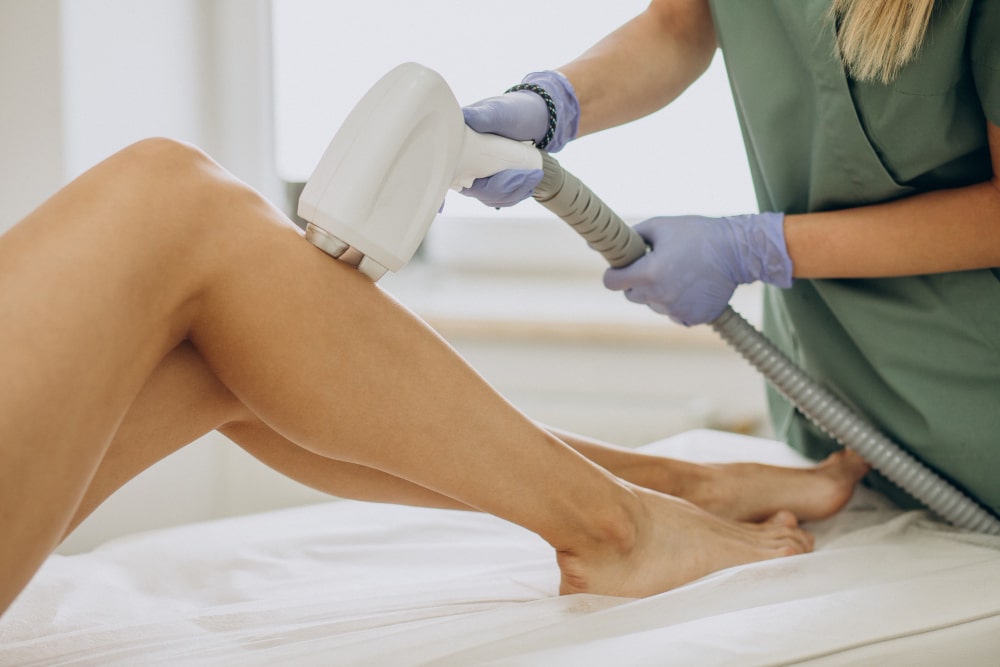Laser therapy is a non-invasive treatment used for decades to relieve pain and reduce inflammation. It uses various lasers with varying intensities to deliver energy into the body, which helps stimulate healing processes and encourages cellular growth. From musculoskeletal pain to sports injuries, laser therapy can treat various conditions safely and effectively. This article will explore the science behind laser therapy, what you can expect from the procedure, and how it compares to traditional treatments. Read on to learn more about this revolutionary form of pain relief.
Understanding Laser Therapy
Laser therapy is a medical treatment that utilizes light energy to stimulate the healing of cells, tissues and organs. It has been used for over 40 years in various forms and is now becoming a popular non-invasive approach to pain relief. Laser therapy works by directing high-intensity light into areas of damaged tissue, allowing it to penetrate up to five centimetres deep. The light energy then interacts with the cells, repairing the damaged tissue through photobiomodulation. This process is thought to reduce inflammation, decrease pain, and promote healing.
How Laser Therapy Works?
Laser therapy works by directing high-intensity light into areas of damaged tissue. The laser’s beam stimulates photo-receptors in the cells, which triggers a cascade of biochemical reactions that promote tissue repair and regeneration. Some of these processes include increased circulation to the affected area, enhanced collagen production, and an elevated release of endorphins, which can reduce pain. The laser’s energy also helps to break down scar tissue and increase the production of fibroblasts – cells involved in wound healing.
Read More: Pain Inside Thigh: Causes, Treatment, and Prevention
Types of Laser Therapy
There are two main types of laser therapy – low-level laser therapy (LLLT) and high-intensity laser therapy (HILT).
Low-level lasers, also known as cold lasers, deliver light at a lower intensity without generating heat. This type of laser has been used to treat various musculoskeletal conditions, including arthritis and tendonitis.
High-intensity lasers, also known as hot lasers, use more powerful light beams to generate heat within the body. This therapy treats deeper tissue injuries such as chronic pain and muscle spasms.
Benefits of Laser Therapy
Laser therapy offers several benefits, making it an attractive treatment for chronic pain or injury patients. It can provide pain relief without needing medication, is minimally invasive, and has minimal side effects. Additionally, laser therapy requires fewer treatment sessions than many other forms of therapy and often leads to accelerated healing times.

Read More: Belly Button Pain During Pregnancy: Causes and Remedies
The Benefits of Laser Therapy for Chronic Pain Conditions
Chronic pain can cause significant disruption to one’s daily life, making it difficult to manage. Fortunately, laser therapy is an effective treatment that can provide long-term relief from chronic pain conditions such as arthritis and fibromyalgia. Here are some of the benefits of using laser therapy for chronic pain:
1. Reduces Inflammation
Laser therapy helps reduce inflammation, which is one of the primary causes of chronic pain conditions. By reducing inflammation, laser therapy can help reduce joint and muscle stiffness and improve mobility.
2. Decreases Pain Intensity
Laser therapy has been shown to reduce pain intensity, which can help reduce the need for medications and improve overall quality of life. Additionally, it can quickly relieve chronic pain, allowing patients to return to their normal activities more quickly.
3. No Side Effects
Unlike medications, laser therapy does not have any side effects. This makes it a safe and effective treatment option for those who want to avoid the potential risks associated with medications.
4. Stimulates Healing
Laser therapy can also stimulate the body’s natural healing processes, which helps reduce pain and promote long-term recovery. Additionally, laser therapy has been shown to increase blood flow to the affected area, which can further aid in healing and improve strength.
Read More: Pain After Ejaculation: Causes, Symptoms, and Treatment
Conditions Treated with Laser Therapy
Laser therapy has been used to treat various musculoskeletal conditions, including successfully.
Musculoskeletal Pain
Laser therapy has been used to reduce pain caused by joint and muscle problems, such as arthritis. It can also be used to help with chronic neck and back pain.
Arthritis
Studies have shown that laser therapy can reduce inflammation and pain associated with arthritis. It has also been reported to reduce joint stiffness and improve function in patients suffering from osteoarthritis.
Sports Injuries
Laser therapy has been used to treat sports-related injuries, such as muscle tears and sprains. Additionally, some athletes have reported that laser therapy can help speed up recovery after an injury.
Read More: Sigmoid Colon Pain: What Causes It, How to Relief Pain?
The Science Behind Pain Relief
Laser therapy works by stimulating a number of cellular processes that lead to pain relief and tissue regeneration. Here are some of the key mechanisms behind how it works:
Cellular Energy Boost
The laser’s light energy stimulates the mitochondria, the cell’s powerhouses, which increases ATP production. This boosts the cell’s energy levels and leads to increased cellular activity.
Anti-Inflammatory Effects
The laser’s light energy also helps reduce inflammation by stimulating the release of anti-inflammatory cytokines, which are molecules that help regulate immune response. Additionally, it can reduce pain by decreasing the body’s production of inflammatory substances such as histamine.
Read More: Stomach Bug While Pregnant: Causes, Symptoms, Remedies
Advantages of Laser Therapy

Laser therapy has several key advantages over traditional treatments such as medications and surgery:
1) Non-Invasive
Unlike drugs or surgery, laser therapy does not involve any invasive techniques. This makes it a safe option for those who are looking for pain relief without the risk of serious side effects.
2) Minimal Side Effects
Laser therapy is generally considered safe and has a low risk of side effects. The most common side effect is temporary skin redness, which usually resolves within a few hours after the treatment.
3) Speedy Recovery
Studies have shown that laser therapy can reduce pain and promote healing significantly faster than other treatments. For example, it has been reported to reduce recovery time for sports injuries by up to 50%.
Read More: Pain in Knuckles: What Causes It, How to Relief Pain?
Laser Therapy vs. Traditional Treatments
Laser therapy is often compared to traditional treatments such as medications and surgery and alternative therapies like acupuncture. Here are some of the key differences between these approaches:
Laser Therapy vs. Medications
Unlike medications, laser therapy is non-invasive and has minimal side effects. It can also provide relief more quickly than medication without the risk of developing a tolerance or dependency.
Laser Therapy vs. Surgery
Laser therapy has fewer risks than surgery, as it involves no invasive techniques such as cutting or stitching. It can also provide relief more quickly than surgery and is generally less expensive.
Laser Therapy vs. Acupuncture
Unlike acupuncture, laser therapy does not require any needles or other invasive techniques. It can also treat a wider range of conditions and provides relief faster than acupuncture.
Read More: Ear Cartilage Pain: What Causes It, How to Treat It?
The Laser Therapy Procedure
The laser therapy procedure typically involves two steps: the application of the laser and the post-treatment care. Here is an overview of what to expect during each step:
Application
Prior to applying the laser, your healthcare provider will assess your condition and map out a treatment plan. During this time, they may also ask you questions about your medical history.
Once the treatment plan has been established, your healthcare provider will apply the laser to the affected area in a series of short pulses. Depending on the severity of your condition, multiple treatments may be necessary.
Post-Treatment Care
After each treatment, it is important to rest and avoid strenuous activities that could aggravate the affected area. Additionally, it is important to stay hydrated and eat a healthy diet to maximize the benefits of the treatment.
Read More: Navicular Bone Pain: What Causes It, How to Relief Pain?
How to Find Laser Therapy Services
If you are interested in getting laser therapy for pain relief, finding a qualified healthcare provider specializing in laser therapy is essential. You can use websites such as HealthGrades or Yelp to search for local providers who offer this service.
When selecting a provider, it is important to research their credentials and read reviews from other patients. This will help you find the best provider for your needs and ensure that you get the highest quality care possible.
You may also ask your current healthcare provider or other local providers for recommendations. This can help you find a qualified, reputable provider experienced in treating musculoskeletal pain with laser therapy.
Safety and Precautions
It is important to note that laser therapy is generally considered safe and has a low risk of side effects. However, certain precautions should be taken before undergoing the procedure:
1) Eye Protection
It is essential to protect your eyes from the laser’s light energy by wearing protective goggles or glasses. Additionally, it would help if you did not look directly at the laser during treatment.
2) Avoid Direct Sunlight
It is important to avoid direct sunlight for at least 24 hours after receiving a laser treatment, as this can increase your risk of skin irritation and sunburn. Additionally, it would help if you covered up with clothing or sunscreen when going outdoors.
3) Follow Post-Treatment Care Instructions
It is also essential to follow the post-treatment care instructions provided by your healthcare provider. This includes avoiding strenuous activities and staying hydrated, as these measures can help maximize the benefits of the treatment.
Read More: Yeast Infection While on Period: What Causes It, How to Treat It?
How much does laser therapy for pain cost?
The cost of laser therapy can vary depending on the type of treatment and the number of sessions required. Some insurance plans may cover part or all of the cost, but it is essential to check with your provider first. Additionally, many providers offer payment plans or discounts for those unable to pay in full.
Conclusion
In conclusion, laser therapy is a safe and effective way to reduce pain and promote healing. It has several key advantages over traditional treatments such as medications and surgery, including minimal side effects, non-invasive techniques, and speedy recovery. It is important to find a qualified healthcare provider who specializes in laser therapy and follow their post-treatment care instructions. The cost of laser therapy can vary, but insurance may cover part or all of the cost. With the right provider and plan, laser therapy can be an excellent option for those seeking an alternative to traditional pain relief treatments.
Read More: Groin Pain When Walking: What Causes It, How to Treat It?
FAQs
No, laser therapy is not painful. In fact, many people find it to be a soothing and relaxing experience.
The effects of laser therapy can see within a few hours of the treatment. However, multiple treatments may be necessary for longer-lasting relief.
The duration of a laser therapy session can vary depending on the severity of your condition. Generally, each session lasts about 10 to 20 minutes.
No, laser therapy is not suitable for everyone. Pregnant women and people with certain medical conditions should avoid this treatment. It is important to consult your healthcare provider to determine if laser therapy is right for you.

